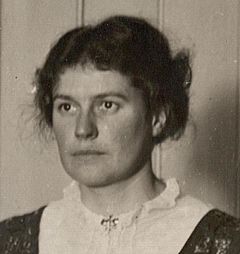Margaret Hills facts for kids
Quick facts for kids
Margaret Hills
|
|
|---|---|

1909 Photograph
|
|
| Organiser (National Union of Women's Suffrage Societies) | |
| In office 1908–1910 |
|
| In office 1911–1913 |
|
| Councillor (Stroud District Council) | |
| In office 1928–1936 |
|
| Councillor (Gloucestershire County Council) | |
| In office 1937–1952 |
|
| Personal details | |
| Born |
Margaret Robertson
1882 St Pancras, London |
| Died | 1967 (aged 84/85) |
| Relatives |
|
Margaret Hills (born Robertson, 1882 – 1967) was an important British woman. She was a teacher, a key organiser for women's voting rights, and a supporter of equal rights for all. She was also a socialist. Margaret Hills made history as the first woman elected to the Stroud Urban District Council. Later, she served as a Councillor on the Gloucestershire County Council.
Contents
Margaret's Early Life and Education
Margaret Robertson was born in London on March 1, 1882. Her father, Henry Robert Robertson, was an artist. Her mother, Agnes Lucy Turner, came from a family with interesting connections. These included people who founded a famous china company and even explorers.
Margaret had three siblings. Her sister, Agnes Arber, became a well-known botanist who studied plants. Her brother, Donald Struan Robertson, was a classicist, meaning he studied ancient Greek and Roman cultures. Her other sister, Janet Robertson, was a portrait artist.
Margaret went to North London Collegiate School. In 1901, she won a scholarship to attend Somerville College at Oxford University. She earned top honors in 1904. At that time, Oxford University did not give degrees to women. So, she later received her Bachelor of Arts degree from Trinity College Dublin in 1906.
She also trained to be a teacher at the Cambridge Training College for Women from 1904 to 1905. After getting her teaching certificate, she worked at a girls' school in Mansfield. By late 1907, she decided to stop teaching. She wanted to focus on the cause of women's voting rights.
Fighting for Women's Voting Rights
Margaret Hills first became involved in the movement for women's voting rights, known as suffrage, in February 1908. She spoke at a meeting in London. Soon after, she began working for the National Union of Women's Suffrage Societies (NUWSS). This group worked peacefully to gain votes for women.
She helped with campaigns in different elections. By July 1908, Margaret was officially listed as an organiser for the NUWSS. The NUWSS was proud to have three full-time organisers, and Margaret was one of them.
In May 1909, she became an organiser for the North of England Society for Women's Suffrage. By 1911, she was the Organising Secretary for the Manchester and District Federation of Women's Suffrage Societies. In December 1912, she took on a new role. She became the organiser for the NUWSS Election Fighting Fund. This fund helped support political candidates who backed women's suffrage.
Margaret was a strong speaker and took part in many public debates. She spoke at a large event at the Royal Albert Hall in London in November 1912. She also spoke in Burnley in 1910.
She also talked to political groups like the Labour Party. She spoke with the Miner's Federation. She tried to convince them to support women's right to vote.
Working for Peace
Margaret Hills was a pacifist. This means she believed that war and violence are wrong. She was against the First World War. In 1915, the Women's International League for Peace and Freedom held a big meeting in the Hague. Margaret was the organising secretary for the British committee. She helped get passports for the women who wanted to attend. She also served on the Executive Committee for the Movement for Democratic Control.
Serving as an Elected Leader
In April 1928, Margaret Hills was elected to the Stroud Urban District Council. This was a local government group. She was the first woman to be elected to this council. She worked hard to improve housing in Stroud. She helped create Stroud's first plan to clear out old, run-down areas and build better homes.
In 1937, Margaret was elected to the Gloucestershire County Council. She continued to serve as a councillor there until 1952. Even after she left the council, she stayed involved. She served on the education committee. Her work is still remembered in Stroud today. A housing area in the town is named after her.
Margaret's Family Life
Margaret met her future husband, Harold Hills, in 1913 while on holiday in Italy. They were introduced by a friend. They announced their engagement two months later. They got married on August 6, 1914. This was just two days after the First World War began.
Harold was a doctor and a military reservist. He had to report for duty right after their wedding. He went to France with the army. He was later reported missing and then found to be a prisoner of war. However, he was released in a prisoner exchange in 1915.
After the war, Harold returned to his work as a doctor. In 1922, Margaret and Harold moved to Stroud. Harold took over a doctor's practice there. They lived at the surgery for a while. Later, they moved to a larger house and then to a smaller one on the same property.
Their first child, Margaret Clare, was born on February 18, 1917.

